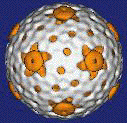Group Group III (dsRNA) Scientific name Cystovirus Rank Genus | Family Cystoviridae Higher classification Cystoviridae | |
 | ||
Similar Corticovirus, Leviviridae, Tectivirus, Microviridae, Chrysovirus | ||
Cystovirus is a genus of viruses, in the family Cystoviridae. Pseudomonas syringae pathovar phaseolicola bacteria serve as natural hosts. There is currently only one species in this genus: the type species Pseudomonas phage φ6.
Contents
Taxonomy
Group: dsRNA
Characteristics
Cystoviruses[1] are distinguished by their tripartite dsRNA genome, totaling ~14 kb in length and their protein and lipid outer layer. No other bacteriophage has any lipid in its outer coat, though the Tectiviridae and the Corticoviridae have lipids within their capsids.
Most identified cystoviruses infect Pseudomonas species, but this is likely biased due to the method of screening and enrichment. The type species is Pseudomonas phage phi6, but there are many other proposed members of this family. Pseudomonas phage φ7, φ8, φ9, φ10, φ11, φ12, and φ13 have been identified and named, but other cystovirus-like viruses have also been isolated. These seven putative relatives are classified as either close (φ7, φ9, φ10, φ11) or distant (φ8, φ12, φ13) relatives to φ6, with the distant relatives thought to infect via the LPS rather than the pili.
Members of the Cystoviridae appear to be most closely related to the Reoviridae, but also share homology with the Totiviridae. In particular, the structural genes of Cystoviruses are highly-similar to those used by a number of dsRNA viruses that infect eukaryotes.
Structure
Viruses in Cystovirus are enveloped, with icosahedral and Spherical geometries, and T=13, T=2 symmetry. The diameter is around 85 nm. Genomes are linear and segmented, and labeled as large (L) 6.4kb, Medium (M) 4 kb and Small (S) 2.9 kb in length. The genome codes for 12 proteins.
Life Cycle
Viral replication is cytoplasmic. Replication follows the double-stranded RNA virus replication model. Double-stranded rna virus transcription is the method of transcription. Pseudomonas bacteria serve as the natural host.
Discovery
Pseudomonas phage phi6 was the first virus in this family to be discovered and was initially characterized in 1973 in James Van Etten's laboratory in the Department of Plant Pathology at the University of Nebraska. They found that when they cultured the bacterial strain Pseudomonas phaseolicola HB1OY with wild Pseudomonas phaseolicola from infected bean straw, there was cytopathic effect, implying that there was a lytic bacteriophage present in their wild Pseudomonas.
In 1999, phi7-14 were identified by the laboratory of Leonard Mindich in the Department of Microbiology at the Public Health Research Institute associated with New York University. They did this by culturing various leaves in Lysogeny Broth and then plating the broth on lawns of Pseudomonas syringae pv phaseolicola. They were able to identify viral plaques from this and then subsequently sequence their genomes.
